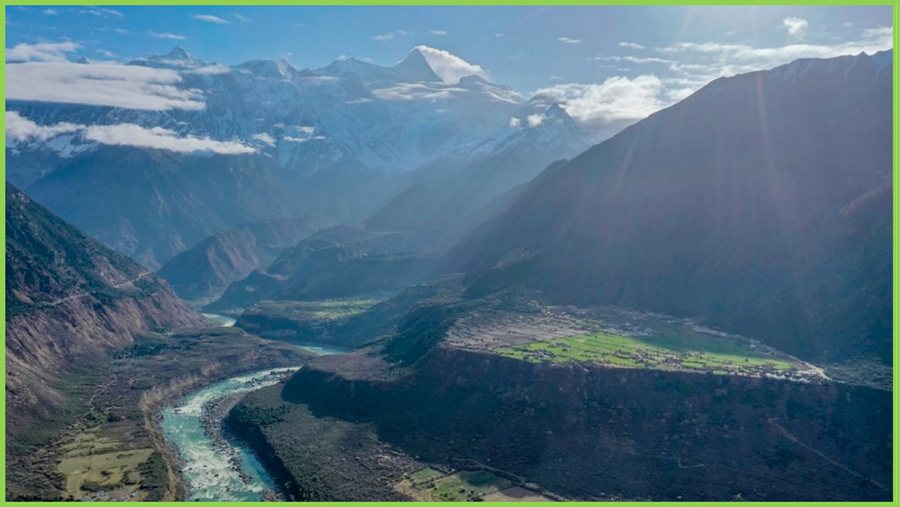
Yarlung Tsangpo River in Nyingchi Province
The Chinese government sees the project as crucial to achieving its goals of reducing pollution by 2030 and achieving carbon neutrality by 2060, meaning reducing greenhouse gas emissions. Renewable energy production, such as hydroelectric power, remains crucial to this process.
 By MSc Roland Tashi, Security Issues Expert
By MSc Roland Tashi, Security Issues Expert
Chinese Premier Li Qiang inaugurated on July 19, 2025, the giant construction site where the Yarlung Tsangpo River dam, as well as the world's largest hydroelectric power plant, will be built.
Strategic investment of this level seems to have begun to "produce", even before the works have begun, contradictions and a major geopolitical impact in the region where the river passes and the reservoirs will be built.
The project was approved several years ago, but was finally funded in December 2024.
A little geography is needed to understand the importance of the river not only for China, but also for the countries it passes through, significantly impacting their agriculture and economy.
The Yarlung Tsangpo River originates from the glaciers of the Kubi Gangri and Ganglunggangri mountains, at an altitude of about 4,700 meters and is almost 3,000 kilometers long.
Along its length, the river flows into Tibet, an autonomous region of China annexed in 1951, while in India, where it is known as the Brahmaputra River, it remains vital for agriculture.
For the economy, the hydroelectric power plant will be a colossal undertaking, costing around 150 billion euros and alone will have a capacity of 70 GW (gigawatts), with an estimated annual production of 300 billion kWh (kilowatt hours).
To put the capacity into perspective, the hydroelectric plant will produce electricity more than double the energy output of Italian hydroelectric power plants combined.
The world's largest hydroelectric power plant is currently located in China, under the Three Gorges Dam on the Yangtze River in Hubei province, while the work that is expected to be built will have a capacity three times greater.
There have been reactions and many objections to the project at interstate levels, due to its numerous impacts on ecology, agriculture, economy, geopolitics, etc.
India, the most "affected" by the project, has expressed concerns about the consequences that the dam could have on the river, which continues its flow in the Indian states of Arunachal Pradesh and Assam, eventually crossing into Bangladesh to empty into the Bay of Bengal.
The dam and hydroelectric power plant will be built near the Tibetan city of Nyingchi, at a point where the river drops from 4,700 meters to about 2,700 meters in less than 50 kilometers.
Five hydroelectric power plants will be built in series and it will be necessary to manage several bends in the river and divert water through tunnels, a very complicated engineering task also due to the need to transport a large amount of equipment and materials to a very remote area.
The project will be managed by China Yajiang Group, a new company created specifically for this purpose. Most details of the works have not been made public and no completion date has been given.
During the presentation of the project, China has given the usual assurances that the work will respect the environment and there will be no changes to the river's flow in its lower part.
The Chinese government considers the project essential to achieving pollution reduction targets by 2030 and the so-called "Carbon Neutrality" by 2060, which means reducing greenhouse gases in the atmosphere, where the production of renewable energy, such as hydroelectricity, remains crucial in this process.
Experts in the field believe that a project of this magnitude could cause irreversible changes in the river's habitat, reduce the population of fish and aquatic life, block the movement of sediments downstream and, consequently, reduce the amount of alluvium that affects soil fertility.
They also estimate that carrying out a very high volume of work will have a high impact on the environment.
From a geopolitical perspective, the hydroelectric power plant is an added reason for tensions between India and China, whose relations have improved slightly in recent years after the June 2020 crisis, when a long-standing territorial dispute in the border region of Ladakh was accompanied by armed conflicts, in which Indian and Chinese soldiers lost their lives.
Diplomacy was followed by the signing of a peace agreement.
In 2024, China appointed a new ambassador to India, and in 2025 direct flights between the two countries resumed.
The problems with China are not only related to the river and the hydroelectric power plant, the Chinese app TikTok remains blocked in India.
Narendra Modi's nationalist government is trying hard to reduce imports from China and promote the country as an alternative for low-cost manufacturing for many international companies, especially technology ones.
China also has a very close relationship with India's main rival, Pakistan.
During the recent crisis in May of this year, India and Pakistan bombed their respective territories for several days, during which Indian aircraft were shot down by the Pakistani air force, which is armed with Chinese-made fighter jets.
The management of Himalayan rivers will continue to affect the tense situation between Pakistan and India after the latter unilaterally suspended the Indus River Waters Treaty.
China could also be involved in this conflict, as the Indus and several of its branches originate there.
What does China gain from this megaproject?
The militarization of infrastructure will remain a concern, as civil engineering works in strategic regions, such as roads, bridges, and tunnels, could later be used for military purposes.
Countries downstream of the rivers, with Bangladesh being the main one, are very sensitive to changes in the amount of water and sediment.
This makes them more dependent on bilateral agreements with China, giving Beijing greater regional influence.
It should be understood that the hydroelectric power plant is part of a broader Chinese strategy to control the water flows of the Himalayas, where rivers that supply water to millions of people in Asia originate.
There is currently no international agreement on water sharing and under these conditions, China can act unilaterally in favor of its interests.
In conclusion, the construction of this major, not only hydraulic, but multidimensional work gives China the opportunity for strategic dominance over the waters of South Asia, creates advantages during regional and global negotiations on climate and energy, and serves as a new tool of diplomatic pressure on India and its neighbors.






















